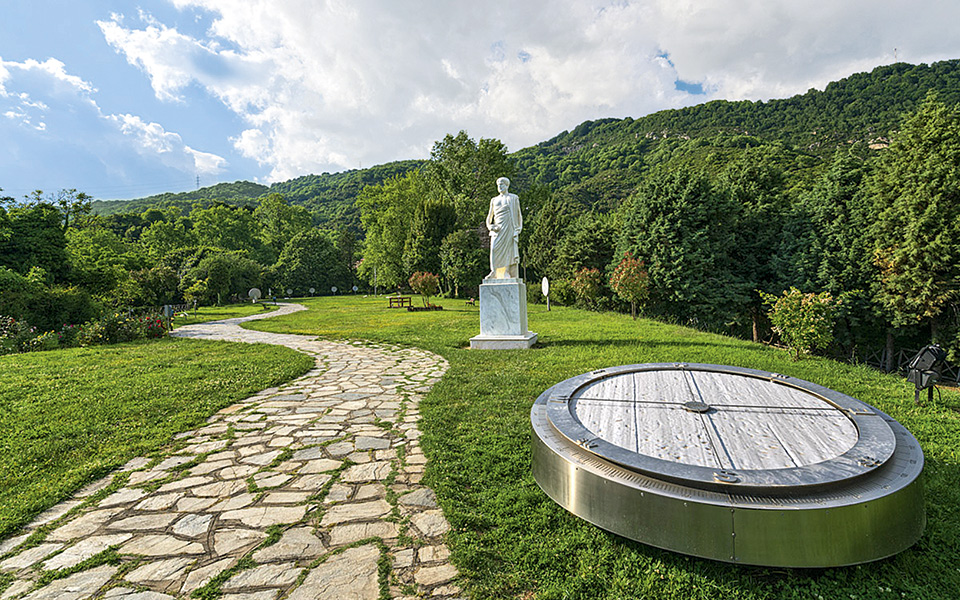Halkidiki is known as a prime destination for beach holidays. Curiously, it’s not very well known for the most important thing by far to have happened here – Ancient Stageira, at the peninsula’s eastern edge, is the birthplace of Aristotle. We are on a tour called “The Footsteps of Aristotle”with Tassos Papadopoulos (of Thessaloniki Walking Tours), who has a way of making history tangible and fresh. Metaphorically and geographically, we are bypassing the Halkidiki of popular culture, cutting straight across its serene top with lakes of glass and hills dotted with haystacks. As we follow the sign for Mt Athos, the forests deepen, the road climbs and twists and the view opens to the sea. A hilly, verdant peninsula is off to the left. This is Ancient Stageira, a rich archaeological site in a setting that, even for Greece, is extraordinary—all the more so for appearing nearly untouched. At the peninsula’s northern edge is the small village of Olympiada; to the south, the only visible signs of contemporary civilization are the stakes of a mussel farm jutting out of the sea. In the distance is the island of Thasos; nearer still is Kapros—an islet named for the wild boar which, with if you really use your imagination, it resembles. The kapros was the sacred animal of ancient Stageira, appearing on their coins (rarest of rare) and, in a half boar/half lion version, over the city’s gate.
If we are to be honest, the heritage we are here to explore in Aristotle’s home city is not just historical and archaeological, but also personal. “How can we live a fulfilling life? How can we live virtuously and well?” Our tour starts with this question; Aristotle was the only one who addressed it directly, concretely. We apply his ideas and his ideals to daily life, or at least we try to. This is how he remains current, relevant, and why from antiquity until the Enlightenment, he was the dominant figure in Western thought.
We’re here to get to know him better, to gaze out at the same views he gazed at while he was becoming who he was. Here among the stones of his childhood (and, somewhere nearby, his own bones, brought back here not long after his death), Aristotle becomes less mythical, more real, and all the more astounding for it.
“If we are to be honest, the heritage we are here to explore in Aristotle’s home city is not just historical and archaeological, but also personal. ”
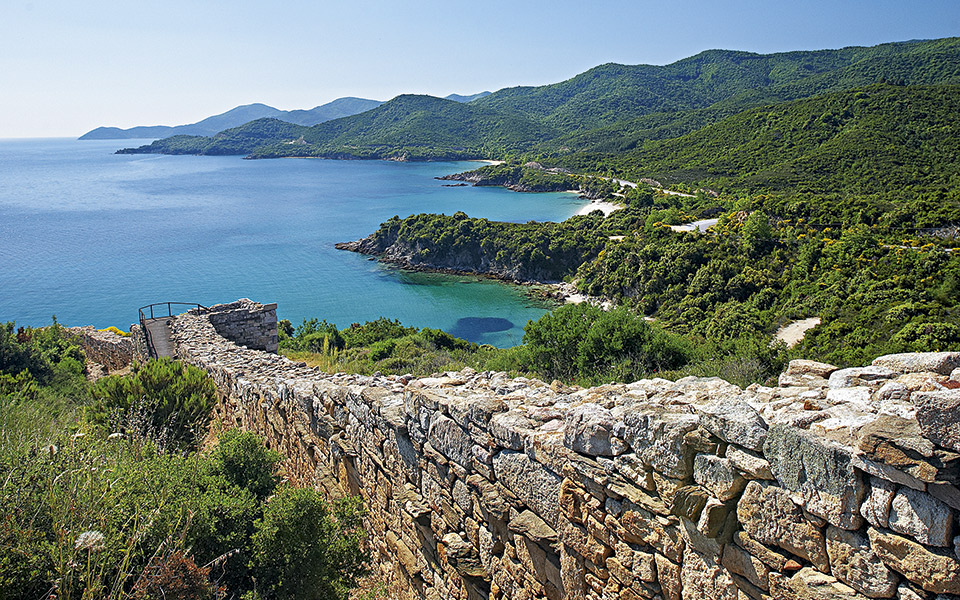
© Ephorate of Antiquities of Chalkidiki and Mount Athos/Hellenic Republic, Ministry of Culture and Sports/Archaeological Receipts Fund
“You come upon things as if you were the first ever to come upon them – it feels more like discovering than sightseeing.”
We start our tour outside the walls of the acropolis, the fortification for military use that was a refuge in times of siege. It’s a special wall, intricate and beautiful in composition and texture — shelves of slate are supported by large stones of marble at staggered intervals, the space between them filled with smaller stones of a third color. Polychromatic, varyingly textured, and with a dynamic rhythm, it is not a style commonly seen among ruins of ancient Greece. Our story and our journey begin here, with Aristotle’s birth into a well-connected family. His father, Nicomachos, was court physician to King Amyntas III (father of Philip II) of Macedonia (his mother, Phaistis, a woman of property from Chalcis in Evia). This relationship with the Macedonian royal family would become pivotal for him, and for Stageira itself.
The ruins are extensive, rambling over the city’s two hills. There is plenty for the imagination to go on, and faithful reconstructions have been added as well. A clay line in the walls clearly delineates the ancient from the restored, but subtly enough so that you can appreciate both the authentic and the augmented. Signage is discreet, minimal, and there are no fences or ropes. You come upon things as if you were the first ever to come upon them – it feels more like discovering than sightseeing. Soon we find the entirely intact foundations of a large, many-roomed house (like Aristotle’s perhaps) that would have looked out onto views of the southern bay. We follow the view to the ruins of entire complexes and the clear traces of the rounded walls of a tower. From the edge of the cliff, we can clearly see Kapros, looking wild and untouched. It’s not, though; it is actually packed with antiquities, as well as some Byzantine ruins.
Back up the hill, the ruins taper off, the foliage thickens, and soon we are in the woods, walking down a path thickly carpeted with leaves. It feels like we’ve left the ruins for the wilderness, but we are still within the walls and what appears untouched is actually – like Kapros – a great cache of finds waiting to be excavated. The woods themselves are key to Stageira’s story: in the 7th century BC, Stageira was settled by colonists from Andros, an island of seafarers, for purposes of trade and war. Their island was dry, rocky and in need of a colony rich in resources. Andros’ fleets were built from Stageira’s forests, and their naval campaigns funded by Stageira’s gold.
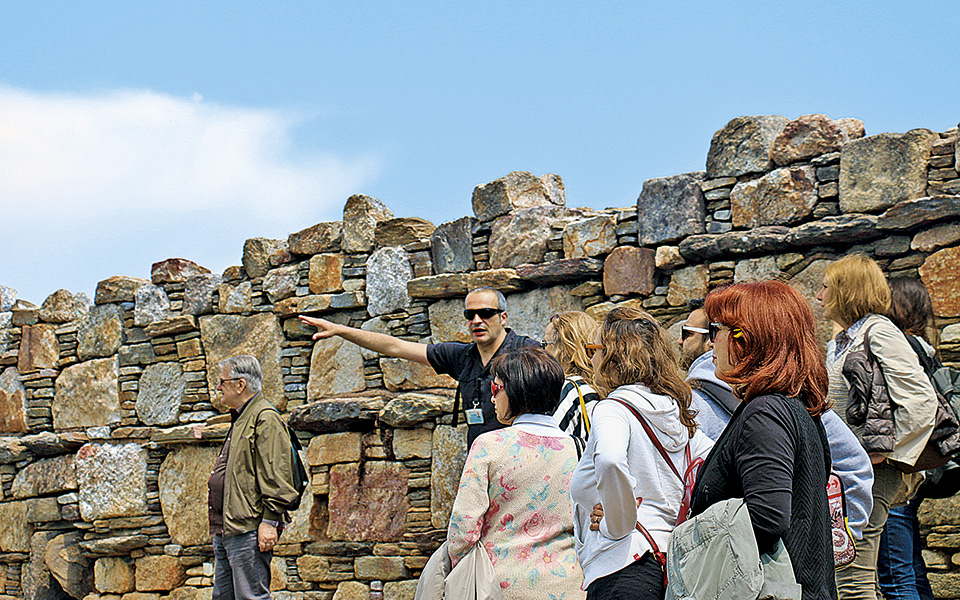
© Ephorate of Antiquities of Chalkidiki and Mount Athos/Hellenic Republic, Ministry of Culture and Sports/Archaeological Receipts Fund
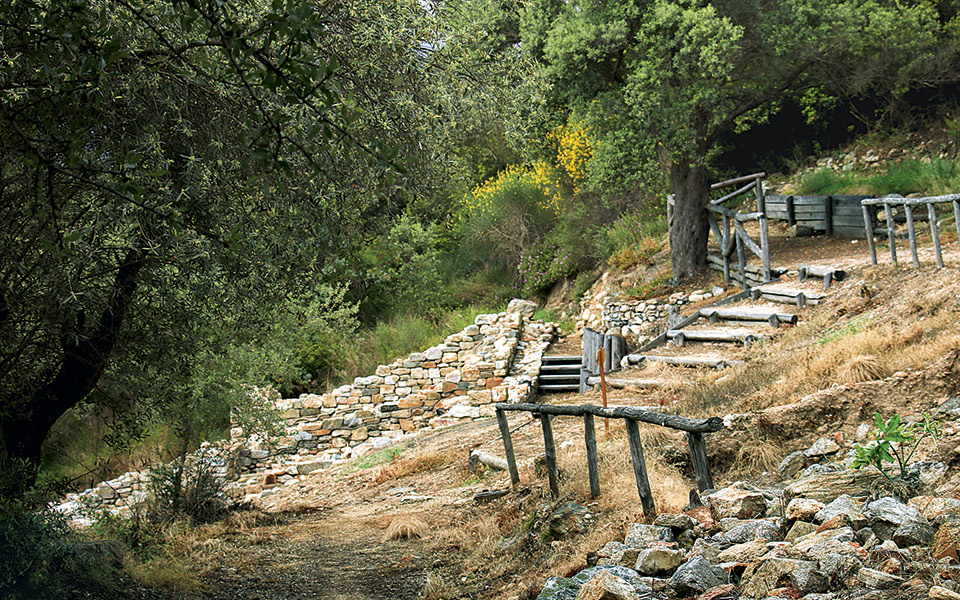
© Ephorate of Antiquities of Chalkidiki and Mount Athos/Hellenic Republic, Ministry of Culture and Sports/Archaeological Receipts Fund

© Ephorate of Antiquities of Chalkidiki and Mount Athos/Hellenic Republic, Ministry of Culture and Sports/Archaeological Receipts Fund
The people of Andros settled the site’s northern hill in the 7th century BC, while the southern hill was developed two centuries later, as the population grew. Now we’re on the crest of the north hill, at one of Stageira’s most significant features: the temple. The intact foundation is formidable (one excavated side extends 30m). Stones of a Byzantine church built on top still remain, but command less of a presence. Deeply charred stone suggests that marble was incinerated to produce lime (calcium oxide), a building material that the Byzantines of AD 1000 may have valued more than the classical statues they most likely destroyed to make it. The few remnants from the original structure that have survived make it easy to fill in the enormous gaps, though; certainly it was once a splendid temple.
For much of his life, Aristotle did not live in Stageira. He left for the Academy in Athens when he was 17 (367 BC), and spent the next twenty years there. When Plato died, it wasn’t Aristotle who succeeded him, but Plato’s nephew Speusippus. Aristotle left Athens and spent the next years inventing taxonomy and biology with his friend Theophrastus of Eresos, in Lesbos. Why did he go there instead of back to Stageira? For one thing, there was no Stageira to return to; the year before Aristotle left the Academy, Philip II of Macedonia (on the throne since 359 BC) destroyed it completely during his successful military campaign in Halkidiki. Stageira’s relevance as the city of Aristotle deepened with this dramatic episode – thanks only to his love for his hometown was Stageira ultimately reborn. When Aristotle finally came north again, in 343 BC, it was to tutor Philip’s heir, Alexander the Great. Apparently, Aristotle commanded his employer’s great regard: he asked Philip to rebuild Stageira, and Philip did.
“The few remnants from the original structure that have survived make it easy to fill in the enormous gaps, though; certainly it was once a splendid temple.”

© Ephorate of Antiquities of Chalkidiki and Mount Athos/Hellenic Republic, Ministry of Culture and Sports/Archaeological Receipts Fund
“A mind that had devoted itself to exploring every knowable thing of the natural world, to ethics, metaphysics and poetics, turned itself in his last weeks towards the well-being of his personal servants.”
This strong relationship with the Macedonian court may have secured Aristotle’s important next step. In 336 BC, Alexander succeeded Philip (stabbed to death at his daughter’s wedding) and, before starting a career of dazzling campaigns that spread Hellenism far and wide, sent Aristotle back to Athens to found his own Lyceum. There, famously, he lectured strolling with his students. They came to be called “peripatetics” (from the Greek word for walking): those who lecture or learn while walking.
Leaving the temple, we pass through shrubbery to arrive at the city’s gate, a place of particular archaeological interest because here there are ruins from all of Stageira’s incarnations: the original colony of Andros, the city rebuilt by Philip and the Byzantine city erected centuries later.Nearby is our final stop: ancient Stageira’s place of public debate, the Stoa (a roofed portico). We sit on the very benches they did, with the bases of the eight columns that once supported the roof standing before us. We’ve been brought to the center of civic life to hear an official document. When Alexander was killed in 323 BC, Aristotle’s relationship with the Macedonian court became a liability. The voicing of anti-Macedonian sentiment was spreading unchecked. Aristotle had been accused of blasphemy and, in order to avert “another insult to Philosophy” (referring to the execution of Socrates), he departed for Chalcis, to lands left to him by his mother. He fell ill, however, and it was there he wrote his will, from which Tassos reads us excerpts.
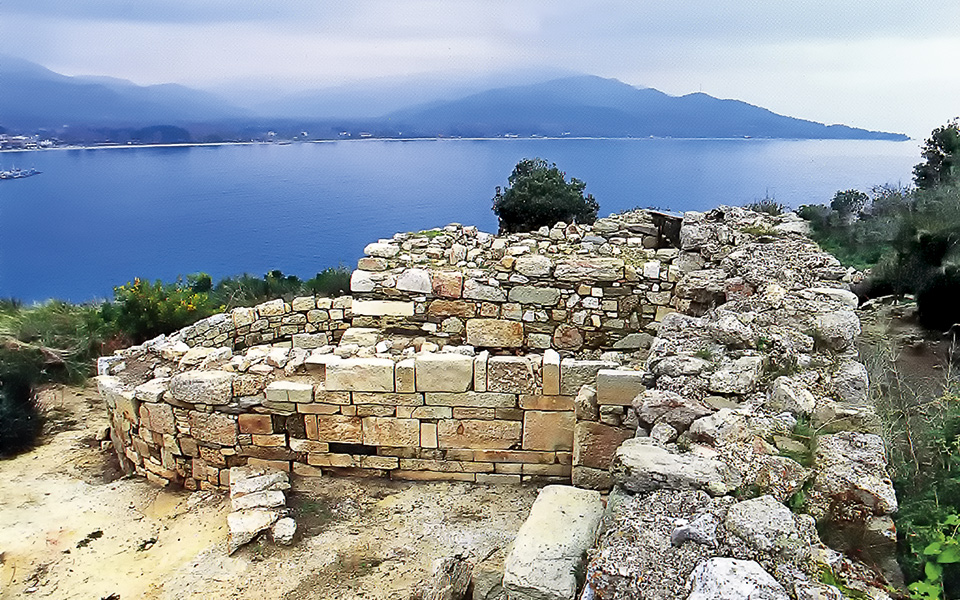
© Ephorate of Antiquities of Chalkidiki and Mount Athos/Hellenic Republic, Ministry of Culture and Sports/Archaeological Receipts Fund
Sitting on the benches of public debate in the town of Aristotle’s birth, hearing the thoughts of this immortal man as he confronted his own mortality with practicality and thoughtfulness, was deeply touching. Ancient Greece has never seemed less of an abstraction, never more vivid than in listening to the philosopher’s genuine concerns for people in the world he would soon be leaving. A mind that had devoted itself to exploring every knowable thing of the natural world, to ethics, metaphysics and poetics, turned itself in his last weeks towards the well-being of his personal servants. In this, we can see him as a person who was the embodiment of the ethics he set forth, the same ethics that we hope guide us still. We started the tour in awe of Aristotle, but now, in addition to our admiration and respect, we find also a deep liking for him. Aristotle died in Chalcis, but the people of Stageira reclaimed his bones, and brought these remains back here.
There is time for further reflection as we wind down the hill in all its lushness. We have one more stop – new Stageira – where there is a park dedicated to Aristotle. It’s filled with activities that allow us to experience various phenomena of physics and of perception that were observed and recorded by the world’s first true scientist. Here, the sobriety of our reflections is surprisingly easy to cast off. We go about the park like children now… Spinning discs with optical illusions, playing on a huge five-tone granite xylophone, creating mad vortexes in a tube of water, whispering to one another across a great distance in order to appreciate the magic of acoustics. We enjoy our hands-on experience of the world – a happy tribute to this most pragmatic of philosophers. There is a large marble statue in the park, but the pedestal does not read “Aristotle;” it simply states “The Stageirite”.
“In this, we can see him as a person who was the embodiment of the ethics he set forth, the same ethics that we hope guide us still.”

